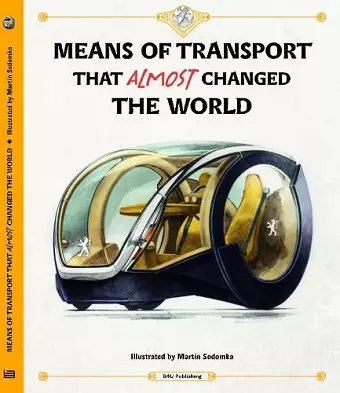Means of Transport That Almost Changed the World
Tom Velcovsky author Stepanka Sekaninova author Martin Sodomka illustrator
Format:Hardback
Publisher:Albatros nakladatelstvi as
Published:17th Aug '23
Should be back in stock very soon

Realistic illustrations accompany the stories behind various more or less peculiar vehicles that were invented but in the end, they did not make the cut.
We all travel sometimes—by car, by public transport, or by plane. But there are some means of transport that we will never be able to use. Let’s open this book and learn how come we don’t travel in flying cars, why trains don’t ride on a single rail, or why there are no life-size remote control cars.
You’re about to be flooded with infamous ideas, prototypes, and crazy attempts at coming up with something new over the course of the last century. The means of transport presented in this book may have not led to a technological revolution but did help us progress. After all, people learn from their mistakes.
Selected for the CBC’s 2023 July Hot Off The Press Reading List (https://www.cbcbooks.org/cbc-book-lists/july-2023/).
"Grades 5-8 This upbeat, obviously well-researched work takes an unusual stance: what's interesting in transportation is what didn't make it--the "average, forgotten, useless, expensive, or insignificant." Vehicles are profiled in depth, including details of what inspired their creation, the history of their design, and why they failed. Well-written, engaging narratives are complemented by detailed drawings that show even small details--no surprise, as illustrator Sodomka is a former design engineer. Examples of the fascinating vehicles include the 1924 Junkers J100, a huge plane that could carry passengers in style for up to 10 hours, but didn't inspire traveler interest; the Hafner Rotabuggy, a flying jeep made for the British Air Force in WWII that took too long to work; and the Conair XFY Pogo, a Cold War plane that could take off and land vertically, but that was too uncomfortable. On show here, besides fascinating, scary, complex machines, is the ingenuity of inventors, the ways social conditions--especially conflict--set invention trends, and how failure can precede success. Though it lacks source notes, this marvelous book is ideal for browsing." —Booklist
"Captivating illustrations really bring these inventions to life, often making readers wish the real versions could be glimpsed working in the real world. For example, a moving walkway, part of the Paris Exposition in the World’s Fair, would have allowed visitors to tour the city while standing still. But it didn’t come without detractors, people were afraid of the moving belt so it didn’t last. But as we know, these days they can be found in department stores and airports in smaller versions." —Vicky Tandy, Athol Public Library
"This was an interesting book filled with the history of transportation. There are examples of experimental transporters from 1900 on. The examples cover cars, planes, and boats. The information covers some of the development and why the transport failed to create an impact. The authors also explain, when relevant, the historical context. There are illustrations of the transport and cross sections when needed. This is a good book for anyone who is interested in history or the various forms of transport. I enjoyed the book for the history that was included." —Morgan Frazier, Librarian
"It seems like there is nothing new under the sun, especially if you have just had an Invention Convention project assigned to you, but this book shows definitely that there is no end to the number of weird and wonderful ways people have thought to improve the way that humans travel from place to place! Everything from an early Parisian moving walkway in 1900 (which we do see remnants of today!) to the 2005 Peugeot Moovie on the cover is examined and illustrated with lovely illustrations with a bit of a vintage vibe. There's just enough information about each vehicle's plusses and minuses that readers will be motivated to find out more about their favorites and maybe even design some vehicles of their own!" —Karen Yingling, YA Books Central
ISBN: 9788000068459
Dimensions: unknown
Weight: unknown
64 pages